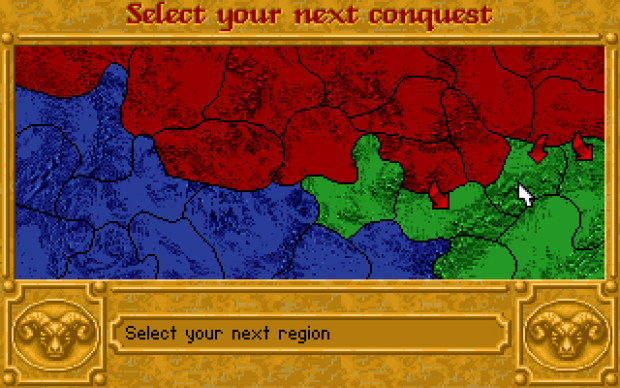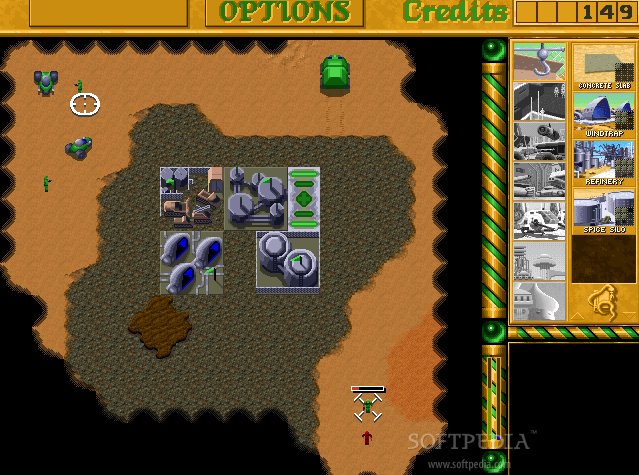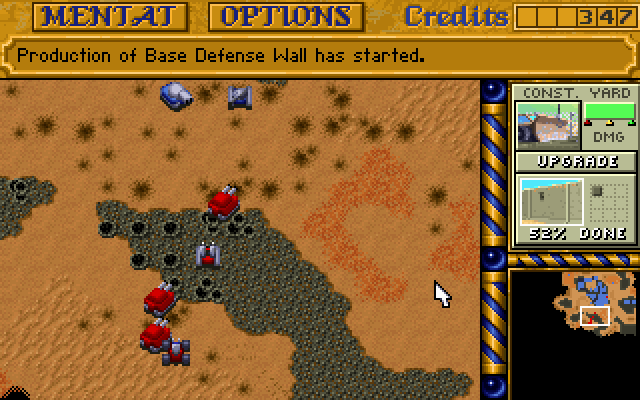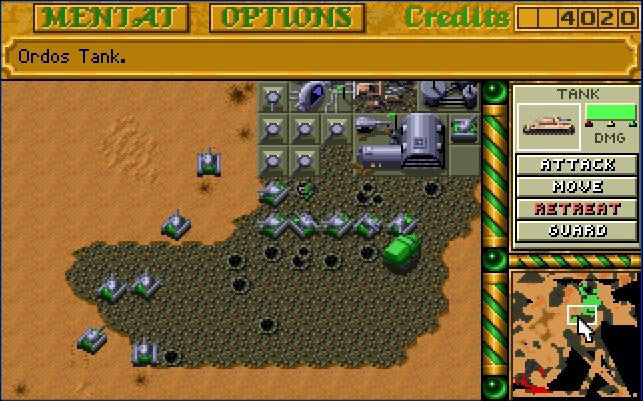Developed by the legendary Westwood Studios and released in 1992. Lets start right of the bat by saying that no other game has done more to define the RTS genre that we know today. A landmark that serves as the archetype for games like Warcraft, Starcraft, Age of Empires, and many more.
Dune 2… The search for Dune 1
Wayback in the 90s, Now defunct Virgin Interactive had in its possession, a license to produce games based on Dune. And during that time, they were producing one… and adventure game. Originally, they were plans to cancel that one and instead focus on another one that stayed truer to the struggles present in Dune like fighting over spice. However, the other game was never canceled. And now the legacy of Dune 2 lies in being a sequel to game with few praise and bearing no real connection to it, only by the property itself.
Early in the development, it’s referenced by several interviews that the 1989 game, Herzog Zwei was one of the most prominent influences on the design of Dune II. It’s mechanically and visually similar (though I say that Herzog still looks better). They share similar units (infantry, tanks, turrets), base capture mechanic with the use of infantry, they even added an air transport unit to simulate the player behavior of picking and dropping units in Herzog Zwei. They also mentioned other influences like Peter Molyneux’s Populous, Military Madness (precursor to the advanced war series), and Sid Meir’s Civilization. Another important influence was the Mac GUI at the time since the game took full advantage of the mouse input.
Game Structure
When you start the game, you are asked to choose from three Houses which represent a faction. They are mostly mechanically identical. Its only when you reach the last branches of their respective tech trees that you notice they have around two or three exclusive units and abilities. Besides that, each house has a different adviser that helps guide the player through the campaign. The advisers help characterize each faction’s personality through their dialog. Although the Campaign plays the same regardless of house, there is a house specific ending.
The campaign mission scenarios were the most realized up to that point. Ancient Art of War (1984) had a dozen scenarios, which varied objectives and starting conditions, but they were not connected and could be played in any order. Mega lo Mania / Tyrants : Fight Through Time (1991) had a campaign, in which the player advanced by defeating scenarios, but they all had the same objective and similar starting condition.
Dune II combined the two so to speak, and added cutscenes to help tell a compelling story. The scenarios aren’t particularly varied. Mostly the objectives are to collect a set amount of credits, and later on, to destroy the enemy structures. But one thing the campaign does well is give you the illusion that you are in strategic control. Before each scenario, you are presented with a risk-style map showing the territories each house controls. You are then presented with a choice of which territory to advance to, which can be unoccupied, resulting in a gather X credits, or in control of one of the other houses, which results in a destroy all enemy buildings scenario.
This structure gives the player the feeling that there is a battle for control of the planet, and that his decisions of which territories to go after affect the outcome. Another element of the campaign design, one that has become a staple in RTS campaigns, is that after each scenario, the player usually unlocks a new stage of his tech tree, allowing the use of new buildings and units. This gives the campaign a natural complexity curve, and motivates the player to complete scenarios in order to find out what new units will be available next.
Gameplay
The actual gameplay itself is familiar to anyone who has played an RTS in the years after Dune II’s release.
Resource gathering is an integral part of Dune II, a reinforcing parallel to Dune’s narrative of the importance of “the spice”. It is the first of its brethren to introduce the mechanic of having specialized individual units actively search and gather a physical resource, and return it to a storage area in order for it to be ready for use by the player. Another important element is the fact that the resource is limited. If your current source becomes depleted, you must find a new source, and most likely fight for it.
It is scattered around the map, visible as red dust on top of the sand. Sometimes, it’s hidden in spice blooms, that must be damaged in order to force it unto the surrounding area. To collect them, you must build refineries and harvesters. The latter, a unit which sole purpose is to harvest the spice and return to a refinery for processing and storage. An important distinction about spice is that it is not a separate from your credits, they are one in the same. Spice is stored in refineries and spice silos. There is a limit to how much you can store inside them. That means if they are up to capacity, any spice collected afterwards is lost. If one of your spice silos or refineries are destroyed, you lose the spice / credits.
Another resource in Dune II is power. Power is produced by buildings called wind farms. Most buildings need a set amount of power to operate. So it’s important to balance the production of new buildings with the power generators.
The most important building the player has is the construction yard. This building is responsible for the building of all structures, except the construction yard itself. You always start the game with one. Buildings can only be built on rocky surfaces and have to be next to another one of your structures. Also, you can place concrete foundations on the surface of the rocks to help cover more space for placing buildings and making sure they don’t require repairs the moment you build them. That’s because without a foundation, they start half-damaged. Some buildings can also be upgraded, giving you access to more units.
Units can be built from certain buildings such as the Barracks, Light and Heavy Vehicle Factory, Starport, or Palace. There are over 15 unit types, from infantry, troopers, quad bikes, tanks, air transport and attack vehicles, and house specific units like the Death’s Hand missile strike, and the Sonic Tank. There is a small limit to how many units one can have in the battlefield, however it can be circumvented by purchasing units directly from the Starport, which sells them at a higher price.
There is a special unit called the MCV, which sole purpose is building more construction yards, and expanding your base beyond the initial rocky patch one starts in. You simply move it to a valid spot covered by rocky terrain, and deploy to build your new construction yard.
The terrain plays a vital role in this game. There are 5 different types of it. Rocky terrain allow for the construction of buildings. Sand covers most of everything else. Essential spice fields will be scattered about. Sand dunes slows down the movement of ground units. Finally, mountains will serve as impassable barriers to all but infantry. There are also hidden dangers in the sand. Sand worms can attack any units wandering about in the sand. They can swallow them whole and retreat. There are also the spice blooms which resemble mounds that when damaged, explode and release spice in the surrounding area. This mechanic alone helps give players motivation to explore the map thoroughly, as they are easily missed.
An an essential feature that this game helped standardize was fog of war. Like today’s RTS games, areas not explored are black. When units move in, they reveal the surrounding area. Though in Dune II, revealed area remains fully visible even if you don’t have any units nearby.
One of the, if not the most influential aspect of Dune II was its interface design and usability They state that they took many inspiration in the GUI of Macs at the time. They wanted to replicate the usability features of operating a computer through a GUI. This made playing the game almost instantly intuitive to anyone who used computers. It bears some resemblance to Nether Earth, but with the availability of the mouse as an input device, it greatly improved the experience. It features the standard game window, where all the action happens. The mini-map, conveniently positioned in the same screen. A unit info section, so you can see the name and health of the selected object. And finally a command section below, for issuing Attack, Move, Retreat, and Guard commands. Most RTS will not deviate from this basic pattern even to this day.
The AI is an improvement from its predecessors. Units know how to move from one point to another without getting stuck or doing weird things, like in Herzog Zwei or Nether Earth. But it still leaves much to be desired. The enemy AI only knows how to send units directly to your base. No flanking and no attacking any other of your other potential bases.
Graphically, the game looks decent. Sprite work is fairly good and they have proper visual design to separate units and factions. On the audio front. It features a notable soundtrack, and actual voices for plenty of actions, like selecting and ordering a unit, which is a standard in RTS games of today.
Dune II’s legacy impact is without question, but it’s certainly not without its fair amount of blemishes. The game moves at a glacial pace, even on the fastest game speed. There are also are certain gameplay elements that worsen the pace and undermines the experience.
The biggest one is the excessive durability of units and buildings. Units take far too long to destroy, even with a small army concentrating fire. Also made worse with the fact that the strongest unit, the missile tank, fires rockets that have a tendency to miss. Buildings are even worse. Though they can be taken quickly with a focused attack, they can be repaired at any time, even while being fired upon. A funny thing about the enemy AI is that they have infinite credits, so your will find yourself trying to take down a structure, only to realize, you don’t have enough firepower to counteract the repair, or have to coordinate your army to concentrate completely on that structure. Because of the slow pace of destroying buildings and units, it can get frustrating quickly.
There is no benefit either in micro-managing units in battle. It becomes hard to get pleasure from engaging in combat. Though, much to my modern RTS standards dissatisfaction, even with a mouse, you still can’t select several units at a time. You have to order desired every unit, one at a time. Finally, no multiplayer. A vital element to subsequent RTS, most notably, Warcraft (which pretty much came about because Blizzard saw a huge opportunity with adding that crucial missing feature.
Thoughts
Many more words can be written about Dune II’s impact. Not only for the RTS genre… but for entertainment as a whole. To put it simply, today’s superstar gaming genre… the MOBA, would not exist without Dune II. A game that had no right to be as influential as it is. Especially for a licensed property. But, by removing the veneer of its legacy, and judging it for what it is, I found a game that is immediately familiar but filled with dated mechanics long since improved. Overall, I enjoyed it. Even with its frustrations, what made it a success in the past can still be felt each time you start a new scenario. May the foundations it laid forever stand, lifting the real-time strategy genre so it can continue to reach higher and higher.






